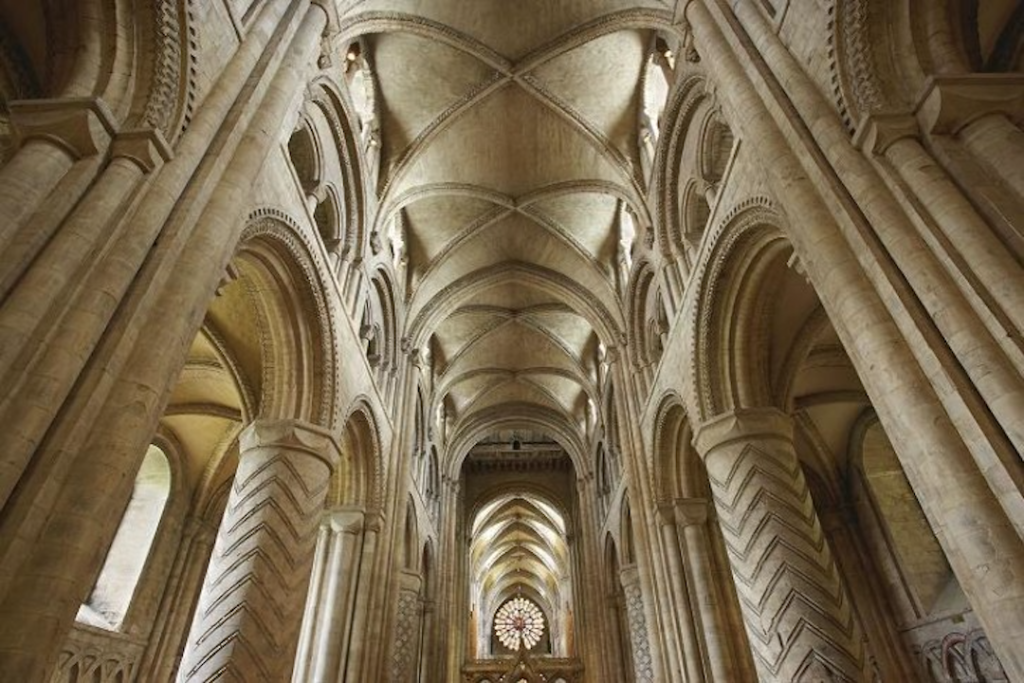Photo Credit: Angel Luciano | Unsplash
A visit to this place will help you to understand a movie line.
The fourth installment in Bucket Bejeweled (“BB”) celebrates the courageous Benedictine monks whose centuries old determination to pay homage to their patron saint produced one of England’s most durable architectural icons. See the introduction to this series here which includes links to other installments in the series.
Friends from Newcastle, England, invited me for a visit. While on a trip with my husband we called on them and then drove the short distance to nearby Durham. There, I heard tell that a while back, some humble monks had built a cathedral while “running away” from the Vikings whose periodic invasions posed a continuous threat in the North of England.

So I thought to myself, any structure built while you are beating a hasty retreat must be fairly modest, no? But boy, was I in for a shock! No assumption could contradict reality more than the one I had made after hearing this fanciful story. Once I set eyes on the cathedral I thought, either the Vikings were moving really slowly or the story had grown into a very tall tale.
The sight of the cathedral took our collective breath away and that was even before we had had a chance to get inside. The story I’d heard is a tall tale indeed that does, in fact, hold a kernel of truth.
The story essentially originates with St Cuthbert of Lindesfarne, born in 634. After a stint in the military, he was drawn to a monastic life, especially the solitary nature of it. But his tendency towards hermitage was often eclipsed by an equally compelling impulse to administer and offer counsel to the poor. As he and his reputation ascended in stature, he rose in the religious ranks and attracted a large following, some of whom testified to the miracles that propelled him to sainthood. St Cuthbert is widely regarded as the most celebrated saint in England prior to Thomas Beckett’s ascendancy to sainthood nearly 500 years later.

The ongoing Viking repeated invasions and threats of invasions lasted centuries after St Cuthbert’s death and in the zeal to protect St. Cuthbert’s remains, his devotees found themselves on the run over the course of just over 100 years!
The acolytes were first obliged to flee his original resting place at Lindesfarne in 875 and then successive groups of monks repeatedly traveled and settled with Cuthbert’s remains until finally arriving in Durham in 999. So, my guess that there had been a “slow run” was real – in a manner of speaking. In Durham, the monks found a naturally protective space owing to the “horse-shoe” shaped gorge formed by the River Wear. St. Cuthbert then earned a reputation as a “protective saint” since his spirit was thought to have guided the “fleeing” monks to this space.
I was gratified to unravel this backstory behind the brief account that “some monks had built a humongous cathedral while fleeing Vikings!”
According to on-line resources, the cathedral itself is regarded as the “finest example of Norman architecture in England” and was a strong precursor to the style we know today as Gothic. Equally, the fact that it has withstood the wear and tear of time and threats of manmade and natural disasters is testament to its durability and perhaps the validity of St Cuthbert’s aura of “protectiveness.”

The structure blew me away on so many levels. Years later, I was grateful that I had laid eyes on this architectural marvel before I saw the film Billy Elliot. No one who hadn’t seen the cathedral would understand the hilarious scene in which a city slicker contemporary of the 11 year-old title character remarks to Billy (an out-of-work coal miner’s son) after the latter introduces himself as hailing from Durham County – “Oh that’s where that amazing cathedral is.” To that, Billy replies blankly – “What cathedral?” When I howled after that line, everyone in the movie theater gave me nasty looks! As a Jersey girl, I likened it to the time when a local NJ born and bred limo driver I hired to take me and my sister from the Jersey shore for a night out in New York had never heard of Broadway!

My biggest epiphany on this visit to Durham came when I entered the Cathedral. We happened to be visiting around Christmas time. Upon entering the church nave, the sounds of children’s voices, Christmas caroling wafted over us. It was enchanting!!! The children at the front were dwarfed by the 73 foot high famously vaulted ceiling. I would later learn all about vaulted ceilings in an adobe building course I took in California where I recalled how impressed I was by the majesty of this structural innovation.

My husband and I stood motionless through one of the carols being rehearsed for an upcoming Christmas celebration. I am not sure how much these children appreciated the privilege of growing up in a country whose history extends back that far and whose history they could touch and experience so palpably.

As an American, I was jealous. Our oldest cathedral was built some 700 years after the humble monks raised the great, imposing structure at the River Wear.





